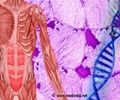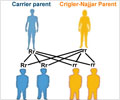Migraines may be caused by gene mutations, researchers from Vanderbilt University Medical Centre have revealed.
By studying a rare, inherited form of migraine, the team of researchers claim to have discovered clues to the biological basis of the painful, debilitating disorder.Lead researcher Dr Alfred George Jr, reports that genetic mutations linked to this rare form of familial migraine alter the function of sodium channels - protein "tunnels" through brain cell membranes involved in the electrical conduction of nerve impulses.
These cellular events may prompt migraines, specifically the aura that precedes them.
During the study the researchers, investigated the physiological basis of a severe, inherited form of migraine called "familial hemiplegic migraine type-3" (FHM3). The aura associated with FHM3 often includes a transient weakness or paralysis of one side of the body.
FHM3 is caused by mutations in a sodium channel gene, SCN1A. A team of researchers in Europe had identified three mutations associated with the condition.
"We were already studying this gene, SCN1A, in genetic forms of epilepsy," said George, the Grant W. Liddle Professor of Medicine, professor of Pharmacology, and the director of the Institute of Integrative Genomics.
Advertisement
Although FHM3 is a rare form of migraine, the findings open up the possibility that more common types of migraine might involve dysfunctional sodium channels
Advertisement
The two other mutants L263V and Q1489K "work as sodium channels but are dysfunctional, they don't operate normally," said George.
The mutations affected the opening and closing of the channel, a phenomenon known as "gating."
Under normal situations, sodium channels are usually closed and open briefly to allow sodium to flow into the cell, which helps generate the electrical current conducted by the cell.
"These dysfunctional sodium channels tend to stay open too long, as if the gating mechanism is stuck. This problem may predispose neurons to fire more frequently," said George.
The enhanced predisposition to nerve cell firing may be the spark that initiates the aura.
"The aura has been linked to a brain phenomenon known as 'cortical spreading depression,' which is essentially a wave of inexcitability that travels across the surface of the cortex (the brain's outer layer).
"The dysfunctional channels probably aren't directly causing the headache. They're likely involved in causing cortical spreading depression, which then triggers other events ultimately culminating in the severe headache," he added.
Source-ANI
RAS/L











